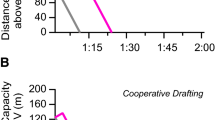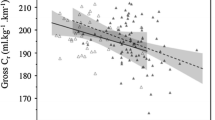Abstract
In order to describe the velocity and the anaerobic energy of two runners competing against each other for middle-distance races, we present a mathematical model relying on an optimal control problem for a system of ordinary differential equations. The model is based on energy conservation and on Newton’s second law: resistive forces, propulsive forces and variations in the maximal oxygen uptake are taken into account. The interaction between the runners provides a minimum for staying 1 m behind one’s competitor. We perform numerical simulations and show how a runner can win a race against someone stronger by taking advantage of staying behind, or how they can improve their personal record by running behind someone else. Our simulations show when it is the best time to overtake, depending on the difference between the athletes. Finally, we compare our numerical results with real data from the men’s 1500 m finals of different competitions.















Similar content being viewed by others
References
Aftalion A, Bonnans J-F (2014) Optimization of running strategies based on anaerobic energy and variations of velocity. SIAM J Appl Math 74(5):1615–1636
Behncke H (1993) A mathematical model for the force and energetics in competitive running. J Math Biol 31(8):853–878
Bonnans J-F, Giorgi D, Grelard V, Maindrault S, Martinon P (2014) BOCOP—a toolbox for optimal control problems. http://bocop.org
Hanon C, Thomas C (2011) Effects of optimal pacing strategies for 400-, 800-, and 1500-m races on the \(\dot{\text{ V }}{\rm O}_{2}\) response. J Sports Sci 29(9):905–912
Hanon C, Leveque JM, Thomas C, Vivier L (2008) Pacing strategy and \(\dot{\text{ V }}{\rm O}_{2}\) kinetics during a 1500-m race. Int J Sports Med 29(3):206–211
Hanon C, Lepretre P-M, Bishop D, Thomas C (2010) Oxygen uptake and blood metabolic responses to a 400-m run. Eur J Appl Physiol 109(2):233–240
Keller JB (1974) Optimal velocity in a race. Am Math Mon 81:474–480
Kyle CR (1979) Reduction of wind resistance and power output of racing cyclists and runners travelling in groups. Ergonomics 22(4):387–397
Mathis F (1989) The effect of fatigue on running strategies. SIAM Rev 31(2):306–309
Morton RH (1986) A three component model of human bioenergetics. J Math Biol 24(4):451–466
Morton RH (1996) A 3-parameter critical power model. Ergonomics 39(4):611–619
Morton RH (2006) The critical power and related whole-body bioenergetic models. Eur J Appl Physiol 96(4):339–354
Pitcher AB (2009) Optimal strategies for a two-runner model of middle-distance running. SIAM J Appl Math 70(4):1032–1046
Pugh LGCE (1971) The influence of wind resistance in running and walking and the mechanical efficiency of work against horizontal or vertical forces. J Physiol 213(2):255–276
Quinn M (2004) The effects of wind and altitude in the 400-m sprint. J Sports Sci 22(11–12):1073–1081
Thiel C, Foster C, Banzer W, De Koning J (2012) Pacing in olympic track races: competitive tactics versus best performance strategy. J Sports Sci 30(11):1107–1115
Thomas C, Hanon C, Perrey S, Le Chevalier JM, Couturier A, Vandewalle H et al (2005) Oxygen uptake response to an 800-m running race. Int J Sports Med 26(4):268–273
Ward-Smith AJ (1985) A mathematical theory of running, based on the first law of thermodynamics, and its application to the performance of world-class athletes. J Biomech 18(5):337–349
Woodside W (1991) The optimal strategy for running a race (a mathematical model for world records from 50 m to 275 km). Math Comput Model 15(10):1–12
YouTube Channel: Beijing 2008 Athletics Gymnastics Aquatics (2008) Athletics—men’s 1500M—Beijing 2008 summer olympic games (video file). https://www.youtube.com/watch?v=0HcGVbDLhI8
YouTube Channel: Athletics (2014) Men’s 1500m final IAAF diamond league Rome 2014 (video file). https://www.youtube.com/watch?v=CTVUGLapmPY
YouTube Channel: Sport Singapore (2015) Athletics men’s 1500m final (day 6) | 28th SEA games Singapore 2015 (video file). https://www.youtube.com/watch?v=pfeVSzDnv-I
Acknowledgements
I would like to thank Frédéric Bonnans for his very helpful comments and A. Aftalion for suggesting this interesting topic of research and for her many remarks. A first version of this work, of which she is co-author, can be found on arXiv (http://arxiv.org/abs/1508.00523v1).
Author information
Authors and Affiliations
Corresponding author
Rights and permissions
About this article
Cite this article
Fiorini, C. Optimization of Running Strategies According to the Physiological Parameters for a Two-Runners Model. Bull Math Biol 79, 143–162 (2017). https://doi.org/10.1007/s11538-016-0230-9
Received:
Accepted:
Published:
Issue Date:
DOI: https://doi.org/10.1007/s11538-016-0230-9




